Developing Account Aggregator Apps Based on Design Principles

In today's digital age, data sharing has become an integral part of our lives. From financial transactions to healthcare records, we constantly exchange information with various service providers and organizations. With the advent of Account Aggregator (AA) apps, the process of data sharing has become more streamlined and secure. These apps enable users to share their financial data seamlessly with third-party institutions while maintaining control over their information. However, designing an effective data sharing mechanism through AA apps requires careful consideration of certain principles. In this blog post, we will explore the essential design principles for data sharing through Account Aggregator apps.
User-Centric Design:
The foundation of any successful AA app is a user-centric design. The user's needs and preferences should be at the forefront of the design process. This involves creating an intuitive and user-friendly interface that allows individuals to easily navigate through the app and share their data with confidence. To achieve this, AA apps should prioritize features like clear and concise instructions, easy-to-understand data access controls, and a seamless user onboarding experience.
Consent and Control:
One of the core principles of data sharing through AA apps is user consent and control. Users should have complete autonomy over their data and be able to grant or revoke access to specific institutions at any time. Designing a robust consent mechanism is essential, which includes features like granular data access permissions, clear explanations of what data is being shared, and the ability to track and manage data-sharing permissions in real-time.
Security and Privacy:
Security and privacy are paramount when designing Account Aggregator apps. Users entrust these apps with sensitive financial information, and it's crucial to safeguard their data from unauthorized access and breaches. Strong encryption, secure authentication methods, and regular security audits should be integral components of the app's design. Additionally, adherence to data protection regulations such as GDPR and CCPA is essential to ensure user privacy is respected.
Interoperability:
Interoperability is a key design principle for Account Aggregator apps, as they need to seamlessly integrate with various financial institutions and service providers. To achieve this, standardized data sharing protocols and APIs (Application Programming Interfaces) should be used. The app's design should facilitate easy integration with a wide range of institutions, ensuring a smooth and consistent user experience across different services.
Transparency and Accountability:
Data sharing and usage should be transparent to users in AA apps. Data-sharing practices should be transparent, including the institutions requesting access and the purposes for which data is being used. Furthermore, all stakeholders should be able to report misuse of data through mechanisms in place.
Data Minimization:
Designing AA apps with data minimization in mind is crucial to protect user privacy. Only the necessary data required for a specific transaction or service should be shared, and excess data should be filtered out. This not only reduces the risk of exposing sensitive information but also makes the data-sharing process more efficient.
Accessibility:
Accessibility is an often-overlooked aspect of app design. To ensure inclusivity, AA apps should be designed to cater to users with disabilities. This includes providing features such as screen readers, voice commands, and compatibility with various assistive technologies. Making the app accessible to all users not only enhances usability but also demonstrates a commitment to equal access.
Data Portability:
Account Aggregator apps should empower users to have control over their data, including the ability to easily export or port their information to other platforms or services. This design principle promotes data ownership and ensures that users are not locked into a single platform.
User Education:
User education is an ongoing process in the design of AA apps. Providing users with clear and concise information about the benefits and risks of data sharing, as well as how to use the app safely, is essential. Regular updates and notifications about data-sharing activities can also help users stay informed.
Continuous Improvement:
Finally, the design of Account Aggregator apps should be an iterative process. Regular feedback from users, security audits, and updates to accommodate evolving technology and regulations are essential. Continuous improvement ensures that the app remains secure, user-friendly, and aligned with the changing needs of users.
It is important to balance user empowerment, security, and usability when designing Account Aggregator apps for data sharing. Developers and organizations can create apps that facilitate seamless data sharing while prioritizing user privacy and control by following these design principles. In the end, a well-designed AA app can enhance the overall digital experience by empowering individuals to make informed decisions about their personal information.



